Black huckleberries (Gaylussacia baccata) are a favorite wild edible because they are easy to find and identify, and tasty enough to eat by the handful. They taste similar to their wild blueberry cousins (Vaccinium spp.), but the larger seeds of huckleberry add a bit of a crunch. The seeds are not so large that you’ll want to spit them out – the crunch is similar to what you get when you eat raspberries or blackberries.
Most people who think the huckleberry’s flavor is inferior to that of the blueberry are probably making an unfair comparison. Huckleberries and blueberries are often found side by side, but black huckleberries ripen a week or two later. So if you taste the two types of berry when blueberry season is peaking, you might be comparing ripe blueberries to not quite ripe huckleberries.
As far as I know, black huckleberries are not grown commercially. Why? I’m not sure, but I find that the yield of berries varies considerably from year to year, and perhaps this makes them too unreliable for commercial cultivation. You have to pick them yourself if you want them, and for that reason, I find huckleberry picking more fun and worthwhile than blueberry picking.
Now let’s move on to how to identify black huckleberry.
General description
This shrub usually reaches 2 to 4 feet in height. Its small, oval leaves with smooth edges are alternately arranged on the twigs. Leaves are green with a faint yellowish cast. The hint of yellow is due to yellow resin dots which are hard to see without a magnifying glass. The leaves turn red in fall.
Black huckleberry flowers

Flowers of black huckleberry (front) are smaller than the white flowers of high bush blueberry (behind)
In spring (mid-May, here in Massachusetts), Gaylussacia baccata produces small, pinkish red flowers with a lantern-like shape, similar to the flowers of blueberry. They are about the same size as the flowers of lowbush blueberry (Vaccinium angustifolium), but smaller than those of high bush blueberry (Vaccinium corymbosum).
These tiny flowers emerge months before the berries ripen, long before you are thinking about foraging for black huckleberries. But that’s why knowing how to identify them is so useful.
Once you know what they look like, you develop a search image for them. Then it’s easy to scope out an area for the flowers in spring, and make note of where you found a large patch black huckleberry. That’s where you should return for summer huckleberry picking. Not to mention the fact these little flowers are beautiful. I look forward to seeing them as much as I look forward to collecting the berries.
Berries of Gaylussacia baccata
The shiny, 1/4 to 3/8 inch diameter blue-black berries ripen in mid-summer. This is mid July to early August in Massachusetts. They look like blueberries and the easiest way to distinguish the two is by tasting and experiencing the noticeable crunch of huckleberry seeds.
You might notice that the berries of some huckleberry shrubs are dusky blue rather than shiny blue-black. Some foragers say that some black huckleberry shrubs produce dusky blue berries, but I think those are probably blue huckleberries, Gaylussacia frondosa, another common species. Blue huckleberries are also tasty.
Where to find black huckleberries
Gaylussacia baccata is a common shrub over most of eastern North America, and can be found in acidic, well-drained sandy soil. As long as those conditions are met, it seems to do well in a wide variety of habitats, from rocky ridge tops to low, moist areas. My favorite place to pick huckleberries is at a ridge top in Berlin., MA, where it dominates the understory for acres and acres, beneath a relatively open, mixed oak forest. My second favorite place to gather them is around a beaver pond in Bolton, MA. It will grow in shade but fruits better in sun or dappled, light shade.
Eating and cooking with black huckleberries
Black huckleberries are sweet and delicious enough to be popped into your mouth by the handful, with no cooking or preparation. They can also be used in place of blueberries in recipes for pies, muffins, breads, etc. For a cool and creamy treat, try my huckleberry swirl lemon ice cream recipe.
Doubts?
In doubt about a plant you’re trying to identify? Then don’t eat it. For further information, I highly recommend Sam Thayer’s books, Nature’s Garden: A Guide to Identifying, Harvesting, and Preparing Edible Wild Plants and The Forager’s Harvest: A Guide to Identifying, Harvesting, and Preparing Edible Wild Plants
. I also suggest that you attend edible plant workshops, which are sprouting up all over the country. Just google it.
Shared on: Wildcrafting Wednesday #119, Heritage Homesteaders Hop #11, Homestead Barn Hop #159, Thank Goodness it’s Monday #70, Homemade Mondays #80, Backyard Farming Connection #80, Natural Living Monday, HomeAcre Hop #70, From the Farm Blog Hop, Simply Natural Saturdays, Tuesdays with a Twist #59, Simple Life Sunday #19











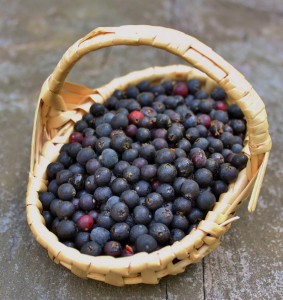
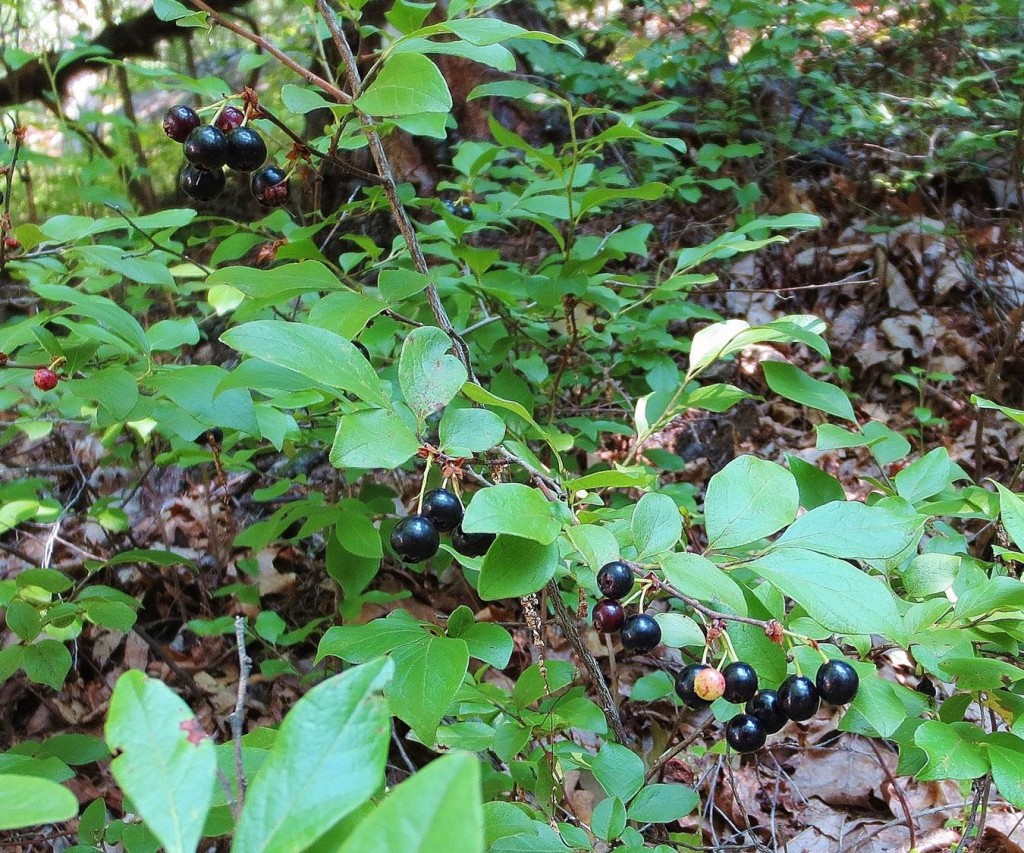
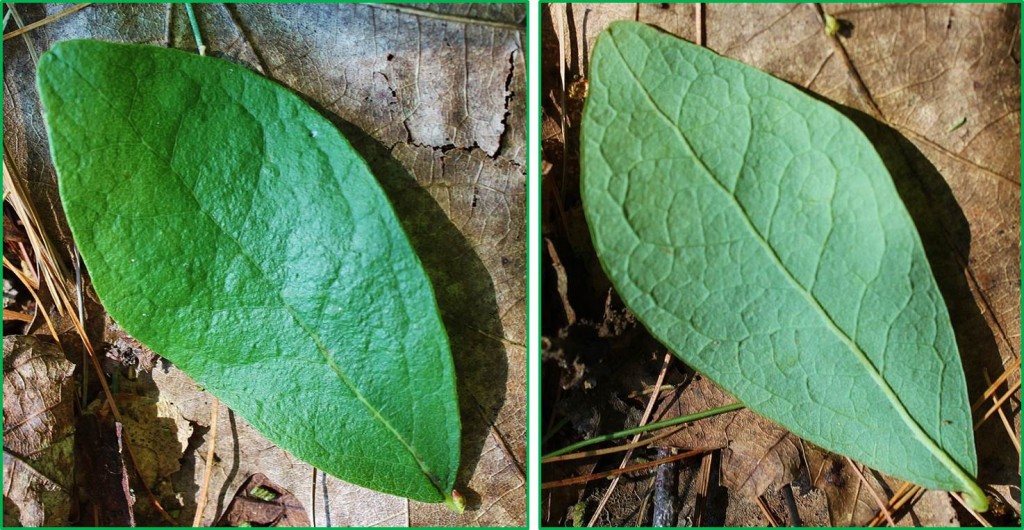
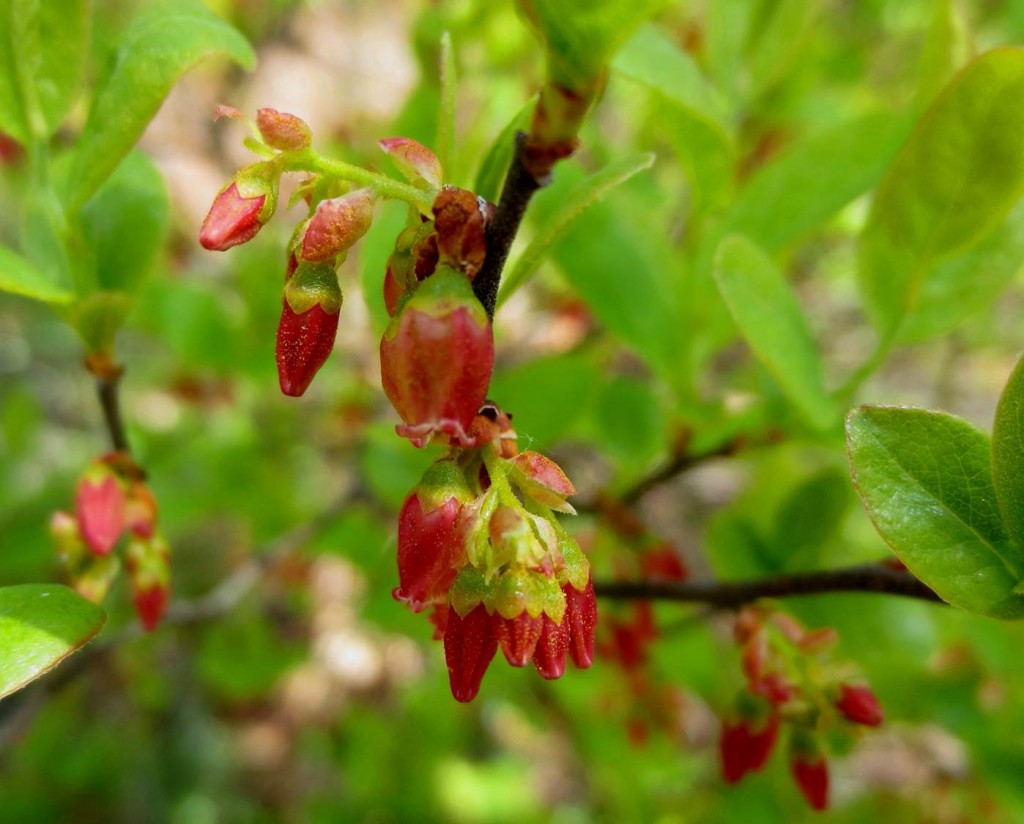
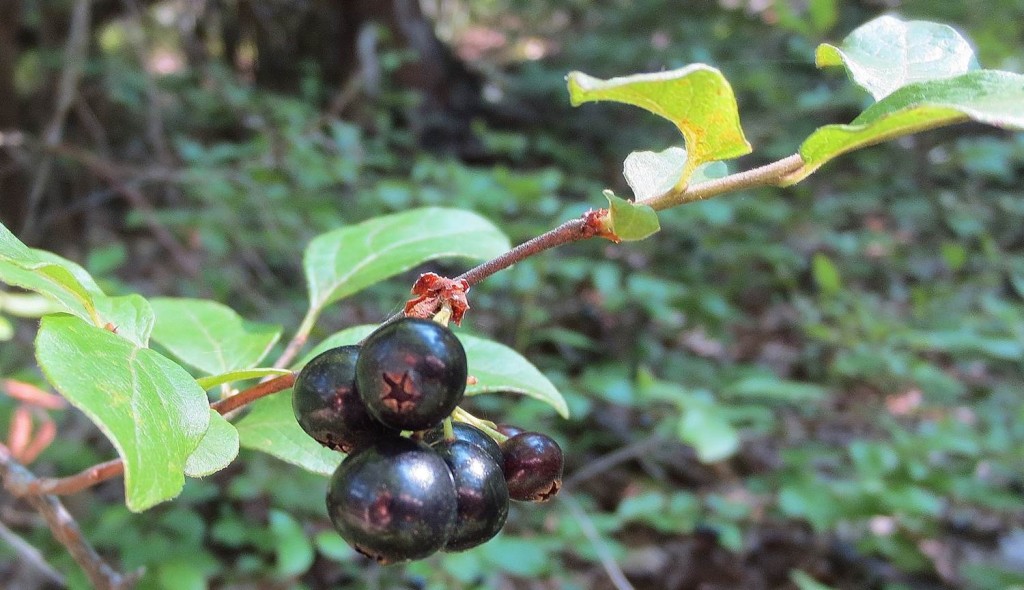
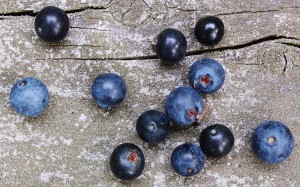
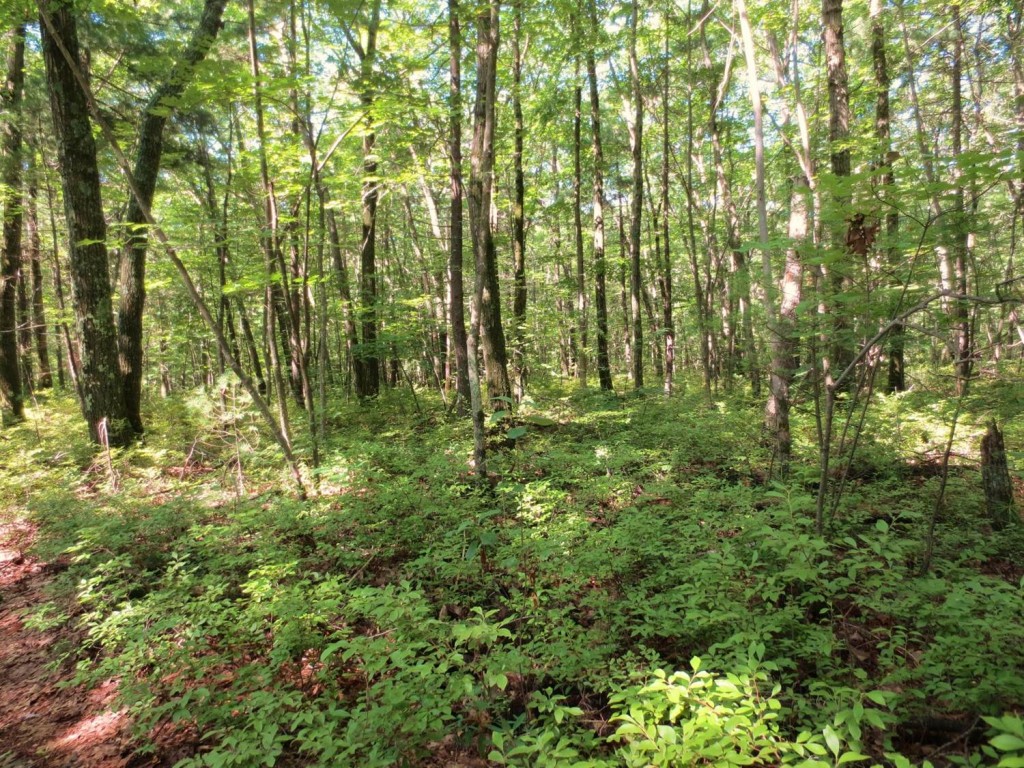
Excellent post, Janet! Your photos represent this shrub well.
You wrote, “Some foragers say that some black huckleberry shrubs produce dusky blue berries, but I think those are probably blue huckleberries, Gaylussacia frondosa, another common species.”
Being familiar with both Blue and Black Huckleberry, I can report foraging and enjoying many “blue” Black Huckleberries, though I’ve yet to find any “black” Blue Huckleberries. In any case, the two can be told apart fairly easily. One way is that the berries of G. frondosa (Blue) are borne on stalks about 1/2-1″ long. The fruit of G. baccata (Black) have stalks about 1/4″ long.
Hey Josh! You may well be right, I just haven’t seen blue Black H’s around here. The dusky blue huckleberries on my stomping grounds are definitely G. frondosa, sometimes growing side by side with G. baccata, so I wondered if people were assuming they are the same species. Anyway, I’m glad you somehow found my blog – it means google knows it’s here, now. Thanks for commenting!
By the way, we’ve conversed before. I’m the Janet on Animal Trackers of New England blog, where you’ve left a few comments in the past.
Excellent, thank you for connecting the dots for me.
Pingback: Huckleberry Swirl Lemon Ice Cream Recipe - One Acre Farm
For folks interested, I’ve posted a photo of some dark blue Black Huckleberries, and a photo comparing fruit clusters of Gaylussacia frondosa and G. baccata on my blog: http://joshfecteau.com/new-moon-challenge-wild-berry-butterfly-recap/
Thanks, Josh, just looked at your photo and it reflects exactly what I see in the field. Not only are the stalks longer on G. frondosa, but the bluish berries are slightly larger, on average, than those of G. baccata.
Pingback: Wintergreen: how to harvest it and make an alcohol extract - One Acre Farm
these are new to me thanks for sharing
come see us at http://shopannies.blogspot.com
I chose to feature this post at PintSizeFarm.com this week (homeacre blog hoop)! Thanks for your submission. I wish we could grow huckleberries, but I’ll have to be satisfied just reading about them 🙂
Thank you so much, Heidi!
Heidi where are you located? Why can you not grow Huckleberries?
Pingback: The HomeAcre Hop #71
Thanks for sharing this great post on The HomeAcre Hop, Janet! I’m featuring it today 🙂 Hope you’ll stop by and share more!
Many thanks, Lisa!!
Pingback: 100+ Homesteading Posts for the Week | HomeAcre Blog Hop
Hello everyone, it’s my first pay a visit at this website,
and article is in fact fruitful designed for me,
keep up posting these types of articles.
Wonderful article! We will be linking to this particularly great post on our
site. Keep up the great writing.
Thanks for your marvelous posting! I definitely enjoyed reading it, you are a great author.I will always bookmark your blog and will eventually come back
sometime soon. I want to encourage continue your great writing, have a nice holiday weekend!
I just like the valuable information you supply in your
articles. I’ll bookmark your blog and test again right here regularly.
I’m slightly sure I will learn plenty of new stuff
proper right here! Best of luck for the following!
That is really fascinating, You’re an overly professional blogger.
I’ve joined your feed and look ahead to in the hunt for more of your magnificent post.
Also, I have shared your site in my social networks
I know this web page gives quality depending articles or reviews and extra information, is there
any other website which offers such information in quality?
I live in blueberry country in Maine. I grow both huckleberries and wild highbush blueberries. Some lowbush as well. I need to comment that wild blueberries are highly variable in color from powder blue to black. There are those who call some of the dark ones Vaccinium nigra. That said the dark berries may be lowbush or high so calling them Vaccinium augustifolia/corymbosum var. nigra is probably better. Wild highbush blueberries are superior to cultivars in most ways except fruit size. Bushier, heartier, and more reliable productivity. Huckleberries seem to not grow as aggressively or produce as much in cultivation.
Hi David, yes what you say about the color of blueberries is true. I didn’t mention that because this post was on huckleberries. I know a lot of people think the flavor of wild blueberries is superior to that of cultivars, but in my personal opinion, the flavor of each is quite variable. And I’ve eaten the occasional box of blueberries from cultivars that topped any wild blueberry I ever popped into my mouth.
Pingback: HUCKLEBERRIES AND THEIR LEAVES-28 AMAZING USES - Reclaiming My Existance
Any chance I can get a few seeds from you? Even if they are frozen , they will germinate..
Hey there! I was harvesting berries in a moist subalpine forest in BC, Canada and came across some berries that grew on shrubs with oval leaves – about 1m tall. The berries looked like blueberries, with the crown-like shape where the flower used to be but they tasted bad. Not in a way that indicated they were rotten. Any ideas on what plant this might be or why this happened? Would it be poisonous? Thanks
I have been reading Thoreau’s “Walden” and came across your site in a quest for information about the huckleberries that gave Thoreau such pleasure. Since you are in Massachusetts, perhaps you can tell me if this is the variety he would have found when he went “a-huckleberrying in the summer” in Concord.
I’ve just recently discovered your site and think it’s an excellent resource! Thank you! I created a native shrub area in a spot that competes for nutrients with 2 red oak trees and a white pine. I planted huckleberries for the fruit and the fall leaf color and because they won’t obstruct the view, as this garden is on the corner. But, due to lots of circumstances, I hadn’t paid much attention to the shrubs in about 3 years. And now, these two lovely bushes are producing. Not lots, but I just enjoyed the harvest. I think I’ll buy a few more. Congratulations on this very comprehensive site.
I live in North Carolina and have fond memories of picking Huckleberries with the family and mom would can some, turn some into jam, some into pies and save some for medicine. I left the area back in 1967 for the Army and when I returned in 1990 they were all gone. Destroyed by the Logging Industry. I have since purchased a few acres of this logged out land and let it get a healthy growth of trees on it. Now I want to reestablish the Huckleberry in those woods. Where would be the best place to get seed or plants to accomplish this?
My dad took our family huckleberry picking every Labor Day in the Multnomah Falls area in N Central Oregon back in the ’60’s. Fond memories of camping and also when we got home of seeing dad enjoying them with vanilla ice cream.
I’m in Idaho now and just bought 5 plants to put in the food forest I’m creating this year.